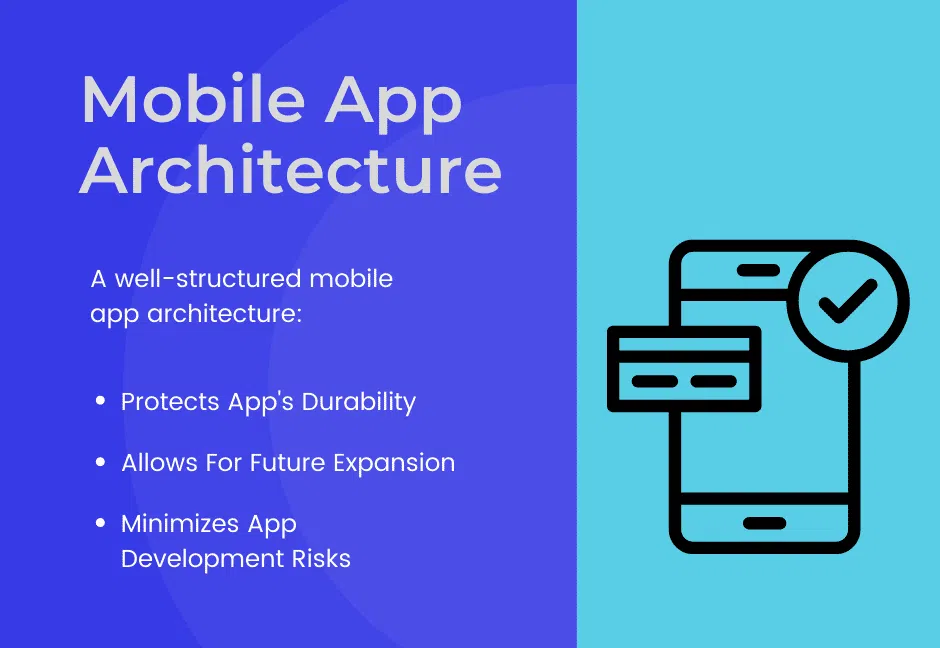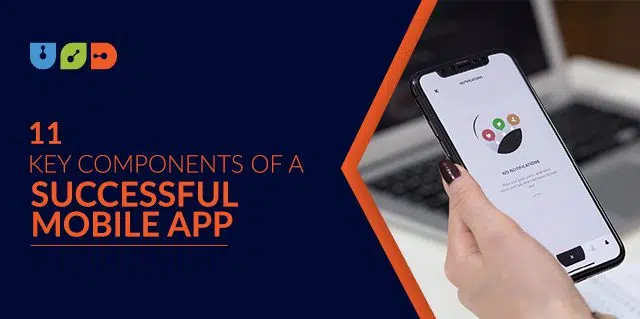Table of Contents
ToggleWhat are the key components of an app that contribute to mobile app development success? Why do some mobile apps and custom software development companies excel in product development? The answer to these questions remains elusive for many. Even after extensive testing, only a fraction of new mobile apps achieves commercial success. This article aims to outline eleven components of an app that act mainly as success drivers. A successful mobile app requires careful planning, attention to detail, and a thorough understanding of the components that make it exceptional.
1. Product Strategy
The first crucial component of a successful mobile app is a well-defined product strategy that addresses both immediate business goals and long-term growth opportunities.
· Define Your Business Goals
The initial step in the mobile app development process involves defining the specific business goals the app aims to accomplish. What business challenge or market opportunity does the mobile app address? The answer can vary depending on the area of the business that offers the most potential for improvement or growth. Some examples include automating business processes, enhancing inventory management, enabling task management, providing customer self-service options, collecting and analyzing on-demand data, exploring new revenue streams, improving customer-facing or internal processes, and developing educational tools for customers or employees.
Mobile apps have numerous potential applications and opportunities for streamlining processes or introducing new value streams for customers. The key lies in selecting the option that aligns most effectively with the broader business strategy.
It’s crucial to consider all aspects of your company’s goals and objectives when formulating the mobile strategy. With limited time, budget, and resources, you may have multiple app ideas but need to prioritize them based on their alignment with the most important business goals. Similar to project analysis techniques used in other areas of business, it’s vital to approach mobile app development with a mindset that ensures the product delivers measurable and intentional business value.
· Establish Your Success Criteria
Success criteria are metrics used to measure the achievement of your mobile app’s goals. These criteria typically encompass cost savings, revenue generation, time savings, task reduction, or specific user actions considered important within the app. Depending on the stage of your project, success criteria can also include user acquisition and retention metrics. Defining measurable key performance indicators (KPIs) allows you to track progress and make informed decisions based on user interactions and experiences with the app. Without clear success criteria, it becomes challenging to gauge whether the app is on track to meet the intended business goals.
· Conduct Market and Competitor Research
Like any business venture, understanding the market you’re entering is essential. Competitive research plays a crucial role in gaining insights. In order to conduct effective research, consider the points mentioned below:
- Differentiate your app’s unique value proposition from competitors.
- Build a competitive analysis spreadsheet.
- Examine competitors’ online presence and app store listings.
- Analyze competitors’ content marketing strategies.
- Conduct direct user research and engage with business experts.
- Monitor indirect competition.
- Attend industry conferences and analyze industry reports.
It’s important to keep competitors under regular scrutiny as they can change over time. By staying updated on their websites, social media presence, and marketing tactics, you can identify areas where your app can differentiate itself. Instead of imitating competitors, use their successes and failures to improve your own strategies, pricing, and features.
· Determine Your Monetization Strategy
Selecting an appropriate monetization strategy for your mobile app is directly related to its value proposition and success criteria. Several monetization models are worth exploring, such as advertising-based revenue, pay-per-download, in-app purchases, freemium models, and subscriptions. Your app’s business objectives should guide your choice of monetization strategy, which needs.
2. Performance and Responsiveness
No user wants to deal with a sluggish and unresponsive app. Performance and responsiveness are critical components of an app that determine its success. A successful mobile app should load quickly, respond promptly to user interactions, and handle data efficiently. It should be optimized to perform well even under challenging network conditions and on devices with limited resources.
3. Compatibility
In the diverse landscape of mobile devices, an app’s compatibility across different platforms, operating systems, and device models is vital. A successful mobile app should be designed to work seamlessly on both iOS and Android platforms, ensuring that it caters to a broader user base. It should adapt to different screen sizes, resolutions, and orientations to provide a consistent experience across devices.
4. Security
In an age where data breaches and privacy concerns are prevalent, users expect their personal information to be safeguarded. A successful mobile app should prioritize security by implementing robust authentication mechanisms, encryption techniques, and data protection measures. It should comply with relevant security standards and regulations to instill trust and confidence in users.
5. Offline Capabilities
Internet connectivity is not always reliable, especially in certain geographical areas or during travel. A successful mobile app should provide offline capabilities to ensure users can still access essential features and content even when they are not connected to the internet. Offline caching, local storage, and smart synchronization are some techniques that can enhance an app’s offline capabilities.
6. Push Notifications
Push notifications are a powerful tool for engaging users and keeping them informed about updates, promotions, and relevant information. A successful mobile app should incorporate push notifications strategically, providing users with timely and personalized messages without being intrusive. The notifications should be opt-in, allowing users to control the frequency and types of notifications they receive.
7. Social Media Integration
Integrating social media into a mobile app can significantly enhance user engagement and virility. A successful mobile app should allow users to share content, achievements, and experiences on popular social media platforms seamlessly. It should also provide social login options, enabling users to sign in or register using their existing social media accounts.
8. Mobile App Architecture
Mobile app architecture involves the necessary methods and principles for constructing apps that are fully functional. These techniques adhere to industry standards and business requirements. A well-structured mobile app architecture protects the app’s durability and allows for future expansion, minimizing risks associated with app development.

· Determining Your Product’s Device
The choice of the device to develop significantly impacts the mobile app architecture. Different device categories, such as smartphones and wearables, require specific considerations. Factors like screen sizes, resolutions, CPU characteristics, memory capacity, and storage capacity should be taken into account when designing the app’s architecture. Identifying the most important platforms and devices before development ensures the architecture aligns with your product’s requirements.
· Consider Multiple Bandwidth Scenarios
Considering various bandwidth scenarios is crucial as users may have limited or no internet connectivity. It’s essential to think about the local networks in your target users’ region and account for low-speed internet connections. Frustration caused by slow connections can lead users to abandon the app, impacting the overall user experience. Therefore, developing the mobile app architecture while considering the worst possible internet connection is vital.
· Creating A Consistent Flow
Mobile app architecture is typically designed with three primary layers: the presentation layer, the business layer, and the data access layer.
The presentation layer comprises UI components and UI process components. It defines the app’s presentation logic and visual aspects. Design choices such as themes, fonts, and colors are made at this stage.
The business layer represents the core functionality of the app and is deployed on a backend server. Offloading business logic to the backend reduces the app’s operating load and improves performance. Factors like response time, loading time, latency, memory usage, and battery consumption impact the app’s user experience.
The data layer encompasses components, utilities, and agents that are responsible for managing and accessing data within an application. It ensures secure and efficient data transactions, playing a critical role in the overall value of the app.
9. UI and UX Design
The user interface design encompasses the layout and overall visual appeal of the app. A successful mobile app should have an intuitive and user-friendly UI that enables users to navigate effortlessly. The UI should be aesthetically pleasing, consistent with the app’s branding, and optimized for various screen sizes and resolutions.
While UI focuses on the visual aspect, user experience (UX) concentrates on how users interact with the app and the overall satisfaction they derive from it. A successful mobile app should provide a seamless and delightful user experience by minimizing friction, streamlining workflows, and anticipating user needs. It should be responsive, fast, and provide relevant and personalized content. There are a few factors to consider for UX design which are as follows.
· Develop a Fast & Responsive Mobile App
Response and loading times are crucial components of an app’s UX design. The performance of a mobile app, which is how well the application performs, is determined by the user’s perception. This includes the app’s responsiveness, startup speed, efficient use of device memory and power, as well the smoothness of animations and interactive elements.
In order to optimize performance, your app should handle network calls and complex computations in a background thread. It is recommended to display a loading indicator when waiting for a server response to keep users informed about the ongoing processes.
Startup time is another aspect of responsiveness that impacts user experience. Users tend to abandon apps that take too long to start. If your app requires multiple tasks before launching, it is essential to minimize the time needed for these tasks and promptly present the user interface. Startup time can be assessed through three models:
- First Screen: The time it takes to display content on the screen.
- Usable: The time required for the app to become functional and interactive.
- Fully Functional: The time it takes for the app to load all resources and reach full functionality.
Of these models, the first two time frames are most critical for a positive user experience. When deploying your app to an app store, you can choose to bundle resources with the application or load them later from a server. Bundling resources increases download and installation time but facilitates faster startup. It is advisable to bundle frequently used resources and those intended for immediate display upon app startup. Less frequently used resources can be loaded from a server in the background while the app is running. The primary objective is to show users content quickly and then enable interaction so that it can handle the remaining tasks in the background.
· Minimize Cognitive Load
Cognitive load refers to the mental effort required to use an app. Designing with minimal cognitive load is essential to prevent overwhelming users. Simplifying the user interface, eliminating unnecessary elements, and offloading tasks can reduce cognitive load. Breaking down complex tasks into smaller subtasks also aids users’ understanding and progression through the app.
· Practice Consistency
Consistency is crucial for successful mobile application design. Using familiar interface screens and standard navigation patterns helps users understand and navigate the app easily. Visual, functional, and external consistency contribute to a cohesive and intuitive user experience. Consistency allows users to leverage their existing knowledge when interacting with your app.
· Design for Accessibility
Designing for accessibility ensures that users with diverse abilities can successfully use the app. Considerations include using visual cues, providing alternatives for audio content, and avoiding jargon that may increase cognitive load. By accommodating users with disabilities, you enhance the overall usability and inclusivity of your mobile app.
10.Personalization and Customization
Users appreciate personalized experiences that cater to their unique preferences and needs. A successful mobile app should offer personalization and customization features that allow users to tailor the app to their liking. This can include personalized recommendations, customizable settings, and the ability to save favorites or create personalized profiles.
11. Continuous Updates and Maintenance
An app’s journey does not end with its initial release. In order to remain successful and relevant, a mobile app requires regular updates and maintenance. A successful app should have a dedicated team that continuously monitors and addresses issues, introduces new features, and incorporates user feedback. Regular updates ensure that the app remains secure, performs optimally, and keeps up with evolving user expectations and technological advancements.
Conclusion
A successful mobile app comprises various key components that contribute to its overall excellence. From the user interface and user experience to performance, compatibility, and security, every aspect plays a vital role. Additionally, features like offline capabilities, push notifications, social media integration, analytics, personalization, and continuous updates ensure that the app remains engaging, functional, and up-to-date. By considering these eleven key components of an app, developers can increase their chances of success in the highly competitive app market. If you want to design and develop a result-oriented mobile app, then contact us today.




























